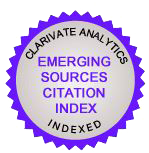Asyndeton Sentences Through the Macedonian Language’s Functional Styles
Keywords:
syntactic synonymy, compound asyndeton sentencesAbstract
In the Macedonian standard language, there are compound sentences that do not have a conjunction or conjunction means between the part-sentences, i.e. there is no information about the relation between the part-sentences (coordination or subordination), as well as information for the type of the compound sentence. The syntactic synonymy contributes the determination of the relation between the part-sentences in the compound asyndeton sentence (the part-sentences can be placed in relation of coordination or subordination), yet the type of the compound asyndeton sentence cannot be determined, because the presence of certain conjunction and conjunction means indicates various types of compound asyndeton sentence. Thus, the research’s aim, through analysis of certain asyndeton compound sentences, is to show that the syntactic synonymy has limitations on the semantic of these sentences, i.e. not all sentences that are a result of the syntactic synonymy are equally semantically acceptable, regarding the standard language norm.The research has qualitative paradigm (content analysis) and descriptive design. The sample consists of three sentences that belong to three various functional styles in the Macedonian language. The sentence are analyzed regarding their possibility to be connected with conjunctions or conjunction means and to form possible syntactic and semantically correct sentences. Synthesis and comparison are methods for processing the data and making inferences.
The results from the research confirm that the syntactic synonymy has limitations regarding the semantic of the sentences, and these limitations differ depending on the functional style that the compound asyndeton sentence belongs to. Therefore, the need to introduce the asyndeton compound sentences as sub group compound sentences in the already existed types of compound sentences arises. For ex., independent compound copulative asyndeton sentences, independent compound adversative asyndeton sentences etc.
Downloads
Downloads
Published
How to Cite
Issue
Section
License

CC BY-SA: This license allows reusers to distribute, remix, adapt, and build upon the material in any medium or format, so long as attribution is given to the creator. The license allows for commercial use. If you remix, adapt, or build upon the material, you must license the modified material under identical terms.
CC BY-SA includes the following elements:
BY ![]() – Credit must be given to the creator
– Credit must be given to the creator
SA ![]() – Adaptations must be shared under the same terms
– Adaptations must be shared under the same terms
Authors who publish with this journal agree to the following terms:
1. Authors retain copyright and grant the journal right of first publication with the work simultaneously licensed under a Creative Commons Attribution License that allows others to share the work with an acknowledgement of the work's authorship and initial publication in this journal.
2. Authors are able to enter into separate, additional contractual arrangements for the non-exclusive distribution of the journal's published version of the work (e.g., post it to an institutional repository or publish it in a book), with an acknowledgement of its initial publication in this journal.
3. Authors are permitted and encouraged to post their work online (e.g., in institutional repositories or on their website) prior to and during the submission process, as it can lead to productive exchanges, as well as earlier and greater citation of published work (See The Effect of Open Access).












